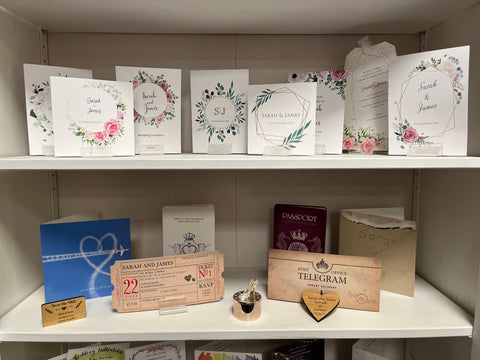Wedding Stationery

Weddings are a celebration of love and union and the role of wedding stationery in these joyous occasions cannot be overstated. Wedding stationery, which includes invitations, save the date cards, order of service and thank you notes is an integral part of wedding planning. These carefully crafted paper pieces not only serve practical purposes but also hold historical significance and provide numerous benefits. In this exploration, we delve into the history, evolution, and the many advantages of wedding stationery.
Part I: The Historical Roots
1. The Origins of Wedding Stationery
The practice of using wedding stationery can be traced back to ancient civilisations. In ancient Egypt, for example, papyrus scrolls were used for wedding invitations. Similarly, ancient China had a tradition of sending red envelopes with money as part of wedding celebrations. These early practices reflect the human inclination to mark significant life events, including weddings, with some form of written communication.
2. Medieval Manuscripts and Heraldry
The medieval period introduced more elaborate forms of wedding stationery. Manuscript invitations and illuminated scrolls, often adorned with intricate designs and heraldic symbols, were used to announce noble weddings. These documents conveyed the grandeur and importance of such occasions, serving not only as invitations but also as keepsakes.
3. The Victorian Era: The Modern Wedding Invitation
The tradition of the modern wedding invitation, as we know it today, began to take shape during the Victorian era. Advances in printing technology and the expansion of the postal system made it easier for couples to send printed wedding invitations. Elaborate designs, intricate calligraphy, and embossed motifs became fashionable. These invitations were often accompanied by engraved calling cards, announcing the event.
Part II: The Benefits of Wedding Stationery
4. Setting the Tone and Theme
Wedding stationery is the first glimpse guests have into the wedding's style and theme. The design, colors, and typography of the invitations establish the tone for the entire event. Whether it's a formal affair, a rustic outdoor wedding, or a tropical destination celebration, the stationery communicates what guests can expect.
5. Personalisation and Uniqueness
One of the significant benefits of wedding stationery is its potential for personalisation. Couples can work with designers and stationery professionals to create one-of-a-kind invitations that reflect their personalities, love story, and shared interests. This personal touch makes the stationery uniquely theirs.
6. Practicality and Information
Beyond aesthetics, wedding stationery serves a practical purpose. Invitations provide essential details, such as the date, time, and location of the wedding, RSVP instructions, and accommodations for out-of-town guests. Having all this information neatly organised in one place simplifies the planning process for both the couple and their guests.
7. Tradition and Sentimentality
Wedding stationery carries with it a sense of tradition and sentimentality. Couples often keep a copy of their wedding invitation as a memento of the special day. These pieces become treasured keepsakes, evoking cherished memories for years to come.
8. Guest Experience and Anticipation
The act of receiving a wedding invitation in the mail creates a sense of anticipation and excitement for guests. The tactile experience of holding the invitation, reading the details, and envisioning the upcoming celebration is a unique and personal aspect of wedding stationery.
9. Coordination and Consistency
Wedding stationery plays a crucial role in maintaining a cohesive look and feel throughout the wedding. From the save the date cards to the thank you notes, a consistent design and theme tie all the elements of the wedding together, creating a harmonious and memorable atmosphere.
Part III: Types of Wedding Stationery
10. Invitations
Wedding invitations are the most significant and formal pieces of wedding stationery. They set the stage for the entire event, often featuring elegant typography and design elements that match the wedding's theme. Invitations include essential information like the date, time, venue and RSVP details.
11. Save the Date Cards
Save the date cards are a relatively modern addition to wedding stationery. They serve as pre-invitations, announcing the wedding date in advance to ensure that guests can mark their calendars and make necessary arrangements.
12. Programmes and Menus
Programmes and menus are used during the wedding ceremony and reception. Programmes provide information about the ceremony order, the bridal party, and any special rituals or readings. Menus, on the other hand, detail the meal options and course sequences for the reception.
13. Place Cards and Seating Charts
For sit-down receptions, place cards and seating charts help guests locate their assigned tables and seats. These elements are not only practical but also contribute to the overall decor and atmosphere of the event.
14. Thank You Cards
After the wedding, thank you cards are used to express gratitude to guests for their presence and gifts. Handwritten thank-you notes add a personal touch and convey the couple's appreciation.
Part IV: Modern Trends and Technology
15. Digital and E-Wedding Invitations
In the digital age, the concept of wedding stationery has extended to e-wedding invitations. Couples can now design and send digital invitations, often via email or custom websites. This technology offers convenience, cost savings, and eco-friendliness.
16. Combining Traditional and Digital
Many couples choose to blend traditional and digital elements in their wedding stationery. For instance, they may send digital save the date cards or invitations but opt for printed programs and place cards. This hybrid approach allows for flexibility and personalisation.
Part V: Environmental Considerations
17. Sustainability and Eco Friendly Options
As environmental awareness grows, couples are increasingly mindful of the ecological impact of wedding stationery. Many couples and stationery designers are exploring eco friendly options, such as recycled paper, soy based inks, and sustainable printing practices.
Conclusion
The history and benefits of wedding stationery underscore its enduring significance in celebrating love and tradition. This essential component of wedding planning carries both practical and sentimental value. Whether it's setting the tone, creating a unique experience, or preserving cherished memories, wedding stationery is a testament to the power of tradition and the enduring importance of the tangible and the tactile in our digital age.
